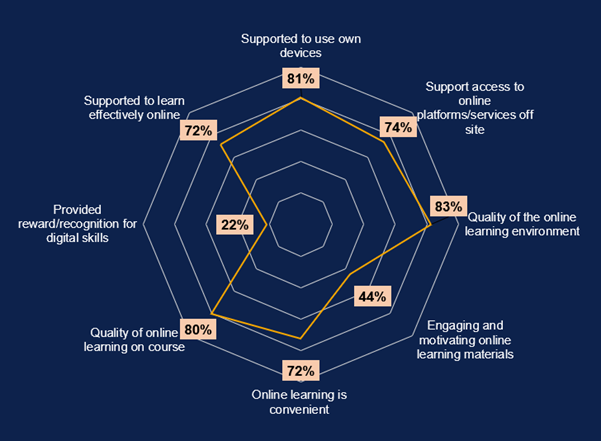Over the course of the conference, we had a wide range of presentations. A theme which emerged for me was the way in which the use of a blended learning approached offered increased accessibility specifically by tailoring module content which suited the needs of students. At Aberystwyth University, we are proud to have such a diverse range of students and provide an inclusive teaching approach. Some of the ways in which our courses have been adapted in response to the challenging teaching circumstances we have had throughout the pandemic had a significant impact on improving accessibility to our students.
Neil Taylor of the Computer Science Department did a fantastic talk on his experiences in creating accessible interactive web-based resources. He was seeking to resolve confusion over the location of documents which he had created to provide information for third year dissertations. He developed a sphinx-doc which compiled all this information into one place and a more easily accessible format. He was able to configure different themes and fonts to suit the needs of the students. Neil’s talk emphasised the importance of the webpage interface design in in ensuring wide accessibility. To find out more click here for the presentation.
Members of the English & Creative Writing Department gave a presentation that presented a case in favour of the hyflex model. Dr Louise Marshall, Dr Malte Urban and Professor Matt Jarvis led the presentation which really evaluated the benefits of the hyflex model of teaching. There was an appreciation by students about the flexibility of the online teaching approach, which meant that whether they were absent due to isolation, illness, or other circumstances, they could still engage with the content and attend the sessions. Two students from the department, Alex and Louise, both spoke about their positive experiences of the hyflex model and how it improved accessibility and inclusivity. I have to admit this was one of my favourite presentations so if you have the chance, please give it a listen. To find out more click here for the presentation.
Dr Tristram Irvine-Fynn from the Geography and Earth Sciences Department gave a presentation of the creation of 3D Fieldtrips to Cadair Idris. This was inspired to complement the role of fieldwork within Geography modules. By adapting resources the department have created a more accessible environment and active learning experience. It is a fantastic learning resource and there is a lot of potential to increase and expand its use. To find out more click here for the presentation.
Kittie Belltree, Mary Glasser, Cal Walters-Davies, & Caroline White from the Student Support and Careers Services gave a presentation on the impacts that blended learning had on neurodiverse students. They noted that not all student experiences of blended learning were particular advantageous and that some neurodiverse students found it difficult to adapt to the new methods of learning and teaching. In the presentation the accessibility service provided information as to the ways which staff can support neurodiverse students and to help ensure their module content is accessible. They also provided a helpful guide to inclusive teaching. To find out more click here for the presentation.
I think what the rapid switch to hyflex model has shown is the potential wider use of different methods of teaching. It has led to lecturers being able to trial and implement bolder methods of teaching and assessment. It has given departments a chance to reflect on the way in which course content is delivered and taught some key lessons and skills which can be used in the further development of course content.




 In this blogpost, we’ll be looking at some tips for monitoring a Teams chat when you’ve also got attendees joining in person and online.
In this blogpost, we’ll be looking at some tips for monitoring a Teams chat when you’ve also got attendees joining in person and online.